If you’re a dog parent, you’ve likely faced the dilemma of what to do with your furry friend when it’s time to travel. We still remember the first time we flew with our dogs — a mix of excitement and some anxiety. With years of flying experience now under our belt, and after hearing from countless other travelers with dogs, we can tell you that flying with a dog is totally doable and doesn’t have to be stressful.
We’ve rounded up everything you need to know to fly with your dog like a pro, from airline policies and paperwork to security procedures and arrival strategies. With this guide, you’ll have everything you need to know to make your trip together a success.
These are the basic steps for flying with a dog ✈️ :
1. Look Up the Airline’s Policy on Dogs
Every airline has specific policies for pets, and these vary significantly between carriers. Before booking your flight, you’ll need to research:
- Cabin vs. cargo
Is your dog small enough to fly under the seat in front of you? Large dogs typically can only fly in cargo. - Breed restrictions
Many airlines ban brachycephalic breeds (such as French bulldogs and pugs) from the cargo hold due to breathing concerns. Some carriers have banned certain breeds entirely. - Reservation limits
Airlines only allow a handful of pets per flight, typically two to six, depending on the aircraft and route. Book early. - Seating restrictions
Expect limited seating options when flying with a dog. Most airlines prohibit pets in bulkhead rows, business or first-class cabins with lie-flat beds, or emergency exit rows.
You might be wondering whether your emotional support animal can fly on planes. Most airlines stopped accepting support animals years ago, but a small number of international airlines still accept emotional support animals. Service dogs are a different story, as the U.S. Department of Transportation still allows service dogs inside airlines, which also means psychiatric service dogs are still allowed on all airlines.
For airline-specific policies, check our detailed guides:
- Alaska Airlines
- Allegiant Air
- American Airlines
- Delta Air Lines
- Frontier Airlines
- Hawaiian Airlines
- JetBlue
- Southwest Airlines
- Spirit Airlines
- United Airlines
Alternative Options: If commercial flights won’t work and you have the means, consider specialty pet travel services like Bark Air. Private jet companies like NetJets and VistaJet also welcome dogs. Flying private costs more (understatement of the year) and leaves a bigger carbon footprint, but you might decide it’s necessary for your dog’s comfort.
Pro Tip: Book a direct flight whenever possible. This minimizes stress for your dog and reduces the chances of complications. Early morning or late evening flights tend to be less crowded and may have more temperature-stable cargo holds for larger dogs.
2. Complete Required DOT Forms
If you’re a service dog handler, The Department of Transportation (DOT) requires specific documentation if you’re flying in the cabin:
- DOT Service Animal Air Transportation Form
Required for all service animals. First time filling out the form? Check out our guide on how to complete the DOT service animal form for complete instructions. - Service Animal Relief Attestation Form
For flights longer than 8 hours
Since the DOT changed rules for emotional support animals in 2021, ESAs are now classified as pets, while psychiatric service dogs maintain their protected status. Service dogs have special rights, like being able to fly in the cabin for free and exemption from pet fees.
If you’re flying with a mental health service dog, check out our complete guide on how to fly with a psychiatric service dog.
3. Schedule a Veterinarian Appointment
If you’re flying internationally, plan a vet visit at least 10–14 days before your flight. Many international destinations will require a current health certificate. Timing is key as health certificates are only valid for a limited period (typically 10–30 days depending on your destination).
This appointment should cover:
- Health certificate
Most airlines for international travel require documentation issued within 10 days of travel - Vaccination records
Ensure rabies and other core vaccines are up-to-date - Travel anxiety discussion
Experts are split on whether pets should be sedated before flights but we recommend avoiding it if possible and acclimating your dog to travel by exposure training - Microchipping
Essential for identification, especially for international travel
Keep multiple copies of all health documentation: one for your records, one for the airline, and one attached to your dog’s carrier. Some destinations may require additional tests or treatments not normally given in routine visits.
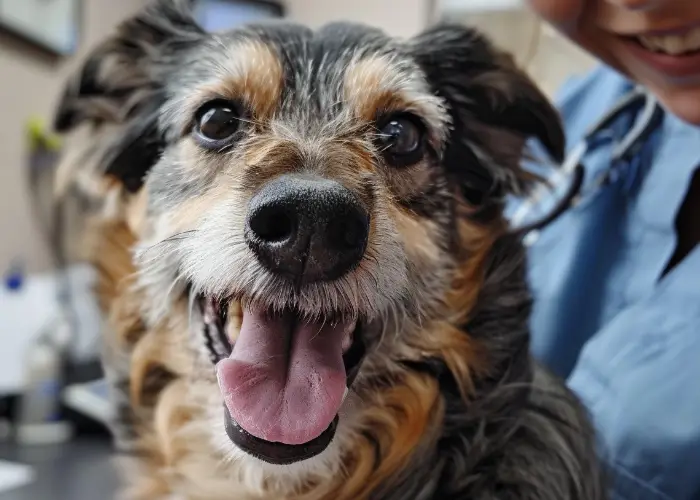
4. Prepare for TSA Security Checkpoints
Airport security can be an annoying experience for both you and your dog. Being prepared will help make this experience easier:
- TSA-friendly carrier
Choose a carrier with minimal metal components to reduce the likelihood of triggering alarms - Practice removal
You’ll need to take your dog out of the carrier while it goes through the X-ray machine - Leash ready
Keep a leash easily accessible — you’ll need it when removing your dog from the carrier - Collar considerations
Remove collars with metal components before going through the detector, or use non-metal options - Extra time
Plan to arrive earlier than usual to allow for the additional screening time
The process differs for service dogs: they remain on leashes and walk through the metal detector with you, while TSA officers may inspect the harness or vest by hand.
You’ll also want to understand TSA’s rules for dog food. Both dry and moist dog food are considered solid food and allowed in carry-on bags. However, security officers may ask you to remove food items for clearer screening of your bag contents.
For more detailed guidance, check our article on how to take your dog through airport security.
5. Have a Plan for Difficult Passengers
Not everyone is understanding about dogs on planes. Being prepared for potential conflicts can help you handle them gracefully:
- Noise management
Pack earplugs to offer neighbors if your dog becomes vocal - Know your rights
Particularly for service dogs, understand exactly what accommodations airlines are legally required to provide - Documentation ready
Keep all relevant paperwork (like your DOT Form) easily accessible - Seating strategy
Request a seat away from other passengers if possible, providing more isolation for your dog
Service dog handlers often face additional scrutiny. Our guide on handling service dog critics on airplanes provides specific strategies for these sometimes difficult interactions.
6. Be Prepared for In-Flight Challenges
For your dog, flying is a sensory overload: strange noises, unfamiliar smells, pressure changes, and limited space. Dogs in cargo also experience separation from you in an environment they don’t understand.
With proper preparation, many dogs handle air travel quite well, though you should consider your individual dog’s temperament.
If your dog is flying in-cabin:
- The carrier must remain under the seat for the entire flight — you can’t get your pup out for snuggles mid-journey. Airlines are strict about this policy for safety reasons, and flight attendants are trained to enforce it.
- Pet carriers count as either your personal item or carry-on bag
- Your dog must be able to stand up and turn around inside the carrier
Pack these essentials in an easily accessible part of your carry-on:
- Collapsible water bowl and small water bottle. Simple silicone bowls from pet stores are often more practical and durable than expensive designer options.
- Comfort item with familiar scents
- Absorbent pads for potential accidents
- Treats for positive reinforcement
For more detailed strategies, read our guide on helping your dog stay calm while flying.
For dogs flying cargo, the experience is quite different. According to the U.S. Department of Transportation, 188,223 animals flew on U.S. airlines in 2022. Among those, seven animals died, one was lost, and one was injured — an incident rate of just 0.48 per 10,000. While those stats mean the vast majority of dogs are usually okay, dog owners understandably still worry about the comfort and safety of their dogs in cargo.
If you have to fly your dog in cargo, choose direct flights scheduled during moderate temperatures and use an airline-approved crate properly sized for your dog. Prepare weeks in advance by acclimating your pet to the crate through short practice sessions. On the crate, attach water bowls that can be filled from outside, secure the door properly, and clearly mark it with “LIVE ANIMAL” stickers and your contact information. Exercise your dog before your flight, and limit food 4 hours before departure while avoiding sedation. Know exactly where to collect your pet at your destination’s cargo facility and be prepared to pick them up promptly.
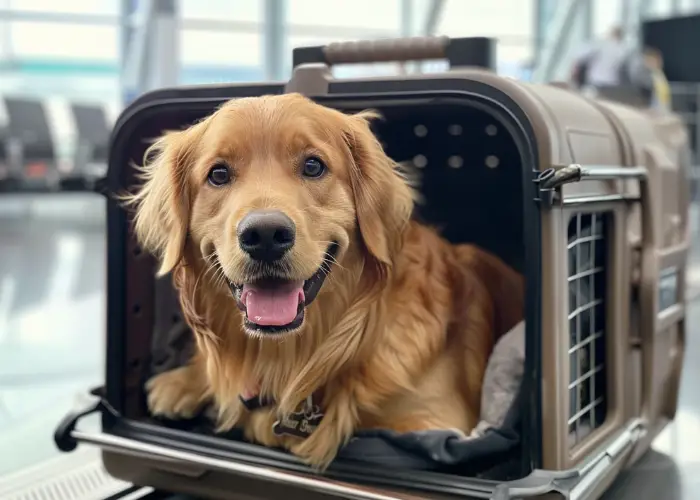
7. Arrive at Your Destination Prepared
Planning for your arrival is just as important as preparing for departure:
- Pet relief areas
Research and locate pet relief areas at your arrival airport. These dedicated spaces for pets to relieve themselves after flights are now available at most major airports. They often have artificial turf, clean-up supplies, and proper disposal facilities. - Transportation
Confirm that your ground transportation accepts pets. Not all taxis, rideshares, or shuttles welcome dogs, so securing pet-friendly transportation ahead of time prevents last-minute scrambling. - Cargo pickup
If your pet flew cargo, know exactly where to pick them up — typically at a separate cargo facility, not baggage claim. These facilities are often located away from the main terminal, requiring additional transit time. - Pickup timing
If you’re flying internationally, check whether the country’s inspection office will be open when you land.
Many experienced travelers check airport maps before departure to identify pet relief areas at both departure and arrival airports. This planning is invaluable during delays when dogs need additional bathroom breaks and immediately upon landing when many dogs urgently need relief after hours in a carrier.
One common scenario many pet owners face involves dogs that have been holding it during a long flight. The rush to find pet relief areas upon landing can sometimes result in accidents. It’s worth considering bringing extra clean-up supplies and allowing significantly more time after landing before rushing to your next destination.
For international travel, be prepared for potential customs inspection of your dog and documentation. Having all your paperwork organized will expedite this process.
Frequently Asked Questions About Flying with Dogs
Are there therapy dogs at airports?
Many major airports now have therapy dog programs to help anxious travelers. These friendly canines wear special vests and are accompanied by handlers.
These programs offer stress reduction through positive interactions. According to research, even brief interactions with therapy animals can lower stress hormones.
Learn more about airports with therapy animals to see if your departure or arrival airport offers this service.
What kind of carrier or crate do I need?
For cabin travel, you need a soft-sided or hard carrier that fits under the seat (typically 17-19″ long, 10-12″ high). The carrier must be well-ventilated, leak-proof, and escape-proof. Your dog should be able to stand up, turn around, and lie down comfortably.
For cargo, you must use a hard-sided crate that’s:
- IATA-approved with metal (not plastic) nuts and bolts
- Large enough for your dog to stand with head fully raised, turn around, and lie down
- Equipped with secure door latches that cannot be pushed open
- Ventilated on all four sides for domestic flights (all sides for international)
- Fitted with a water bowl that can be filled from outside
- Lined with absorbent material
- Marked with “LIVE ANIMAL” and arrows showing correct orientation
Which breeds are restricted from flying?
Most airlines restrict or ban snub-nosed (brachycephalic) breeds due to breathing risks: Bulldogs (all types), Pugs, Boston Terriers, Boxers, Pekingese, Shih Tzus, Mastiffs.
Check with your airline before booking your tickets to see their current restriction list.
What are the size and weight limits for dogs?
Check with your airline for their exact numbers, but these are some general guidelines:
In-Cabin:
- Combined weight (pet + carrier): usually limited to 20 pounds
- Carrier must fit under seat: typically 17″ x 12″ x 9.5″ for mainline flights
- Slightly smaller dimensions for regional jets
- Dog must be able to stand and turn in carrier
Cargo:
- No strict weight limit, but crate size matters
- Maximum crate size varies by aircraft type
- Crate height = dog’s height from ground to top of head/ears when standing
- Crate length = dog’s length from nose to tail plus half their leg length
- Width = twice the dog’s shoulder width
How do layovers work with dogs?
Flying with your dog through a connection requires extra planning. For in-cabin travel, your dog stays with you but must remain in their carrier while you navigate the airport (unless they are a service dog). Plan on at least two hours between flights to handle pet relief breaks and potential security rescreening — many airports now have dedicated pet relief areas inside security.
Cargo is more complex. Your dog may be transferred to the connecting flight by airline staff who monitor them in temperature-controlled areas and check on them periodically. For international connections, you might face additional paperwork or inspection requirements. If your layover stretches beyond four hours, the airline might require you to pick up and recheck your dog.
If you have a long layover, talk to an airline agent and make sure you clearly understand how your dog will be handled in cargo so you can ensure their comfort and safety.
What’s the difference between pets, ESAs, and service dogs when it comes to flying?
The rules for flying with dogs vary significantly based on their status. Service dogs have the most access rights. These are working animals trained for specific tasks to help people with disabilities. They can fly in the cabin without a carrier, though they must be harnessed and well-behaved. Airlines may ask for a Department of Transportation form, but they can’t charge fees or deny access based on breed.
The rules for emotional support animals have changed dramatically. Airlines no longer grant them special treatment. If you fly with an ESA, it must follow the same rules and fees as regular pets. This means fitting in a carrier under the seat or traveling in cargo.
Regular pets need an airline-approved carrier and health certificates for international destinations, and you’ll pay a fee each way. Airlines limit the number of pets per flight and have strict size and age requirements. Book early — these spots fill up fast, especially during peak travel seasons.
Qualify for a Psychiatric Service Dog Letter Online
Get the assistance you need to live a fulfilling life!
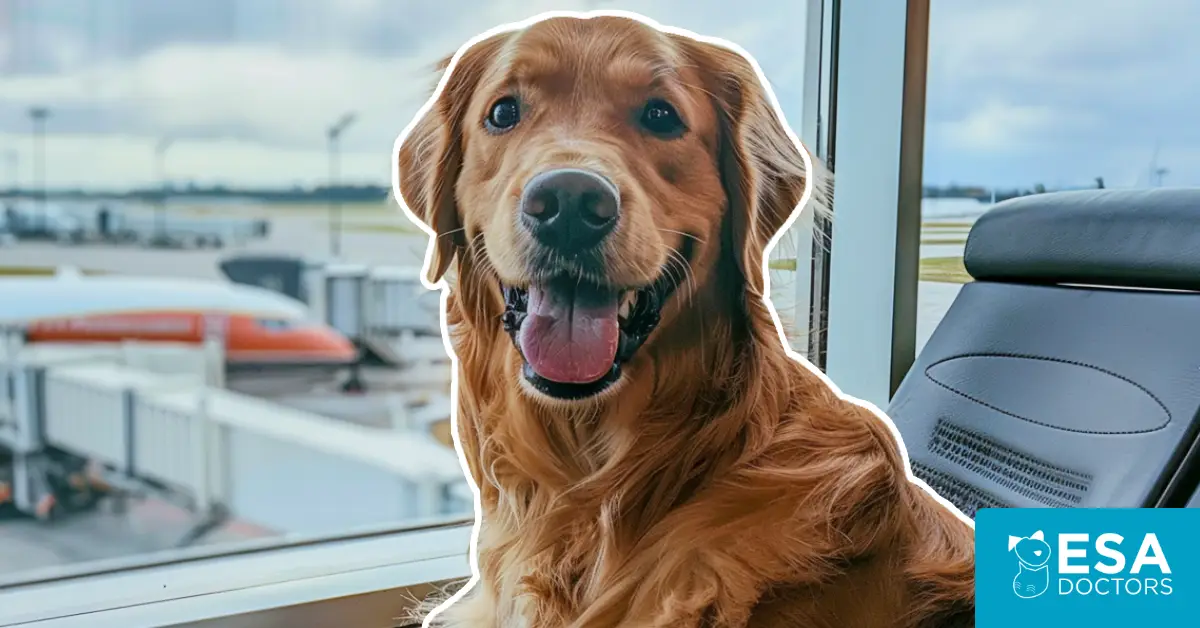


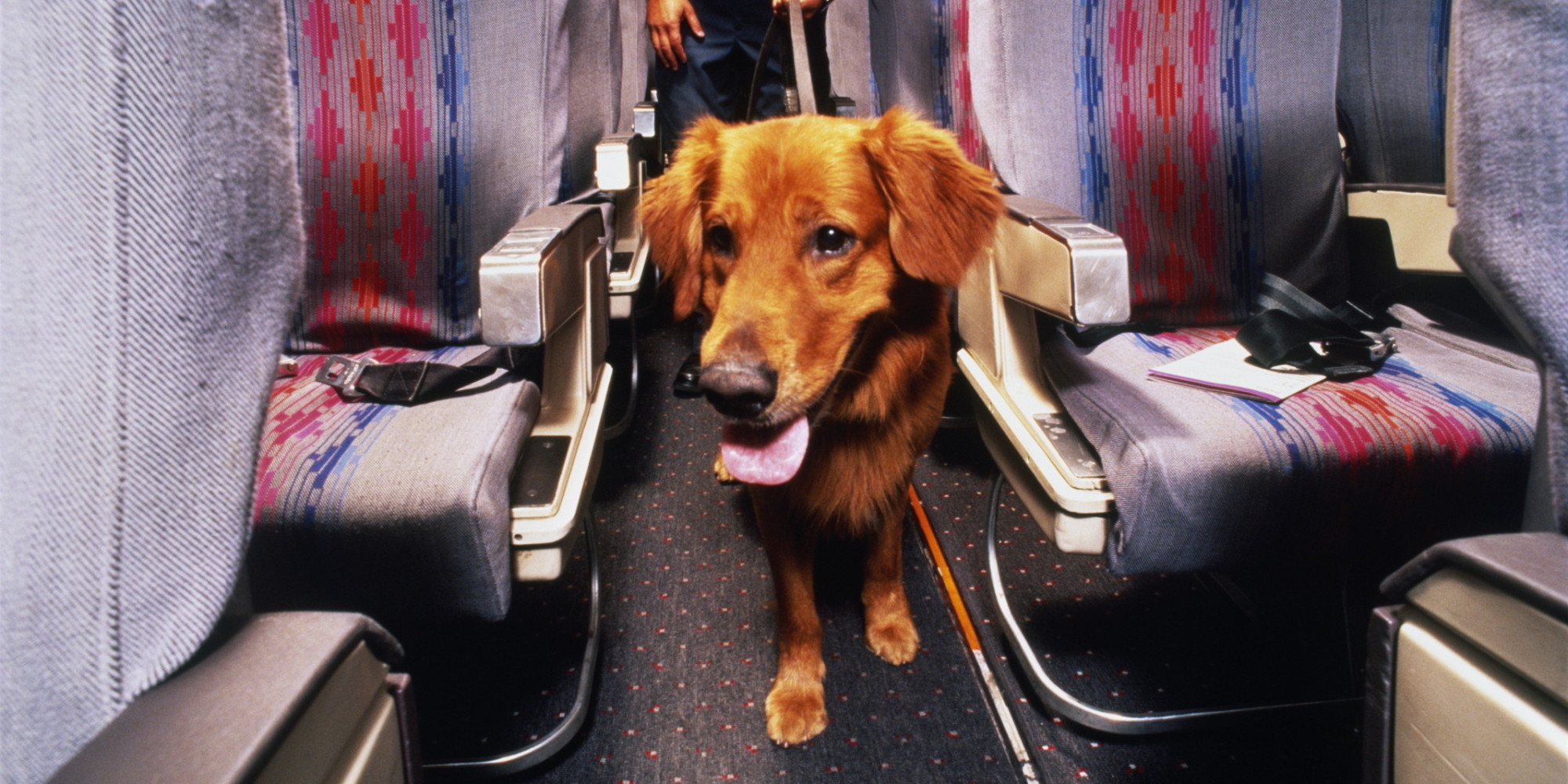
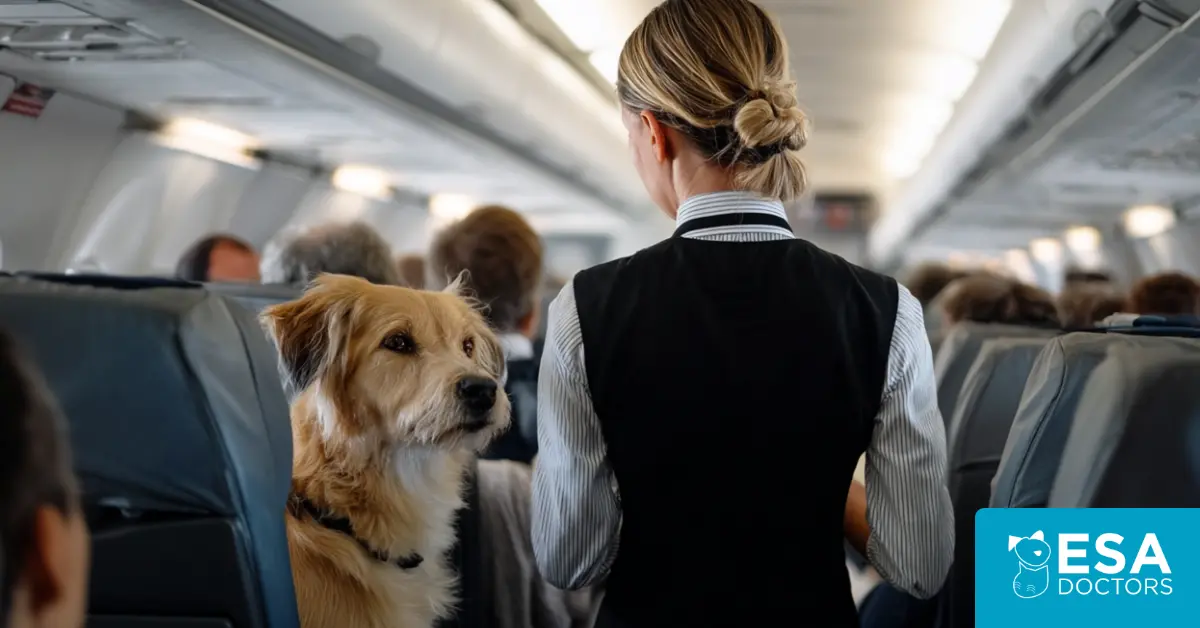
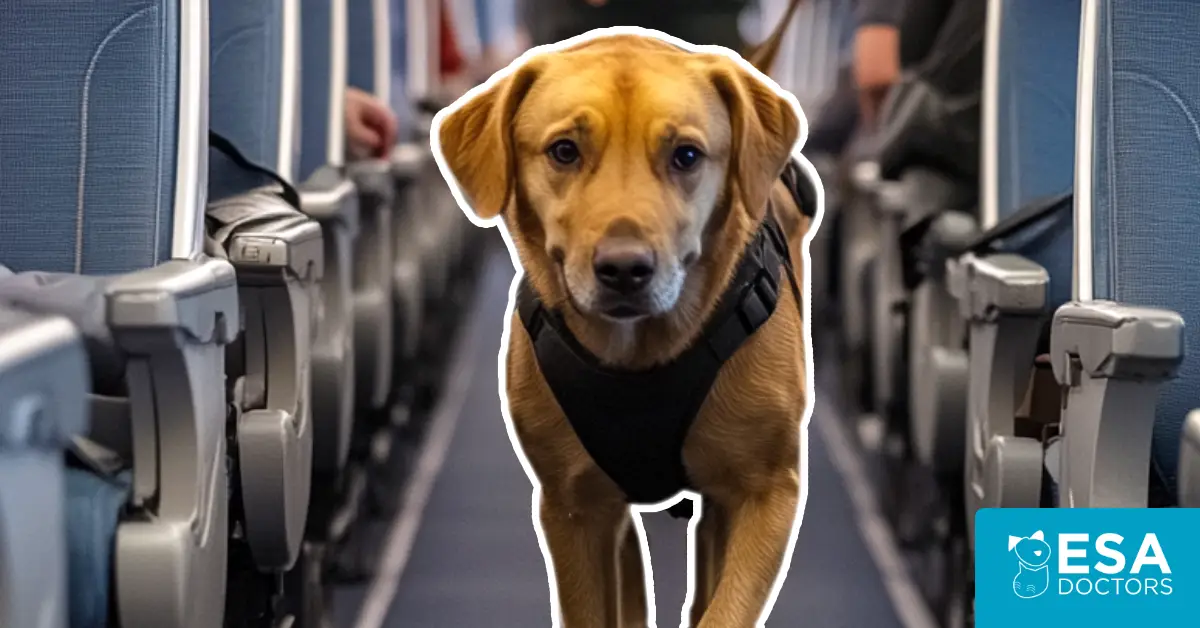
Leave a Comment